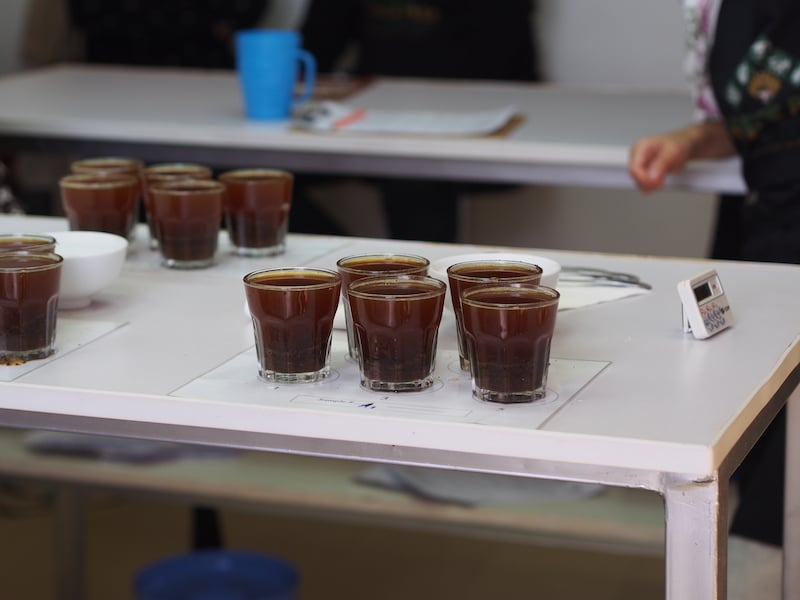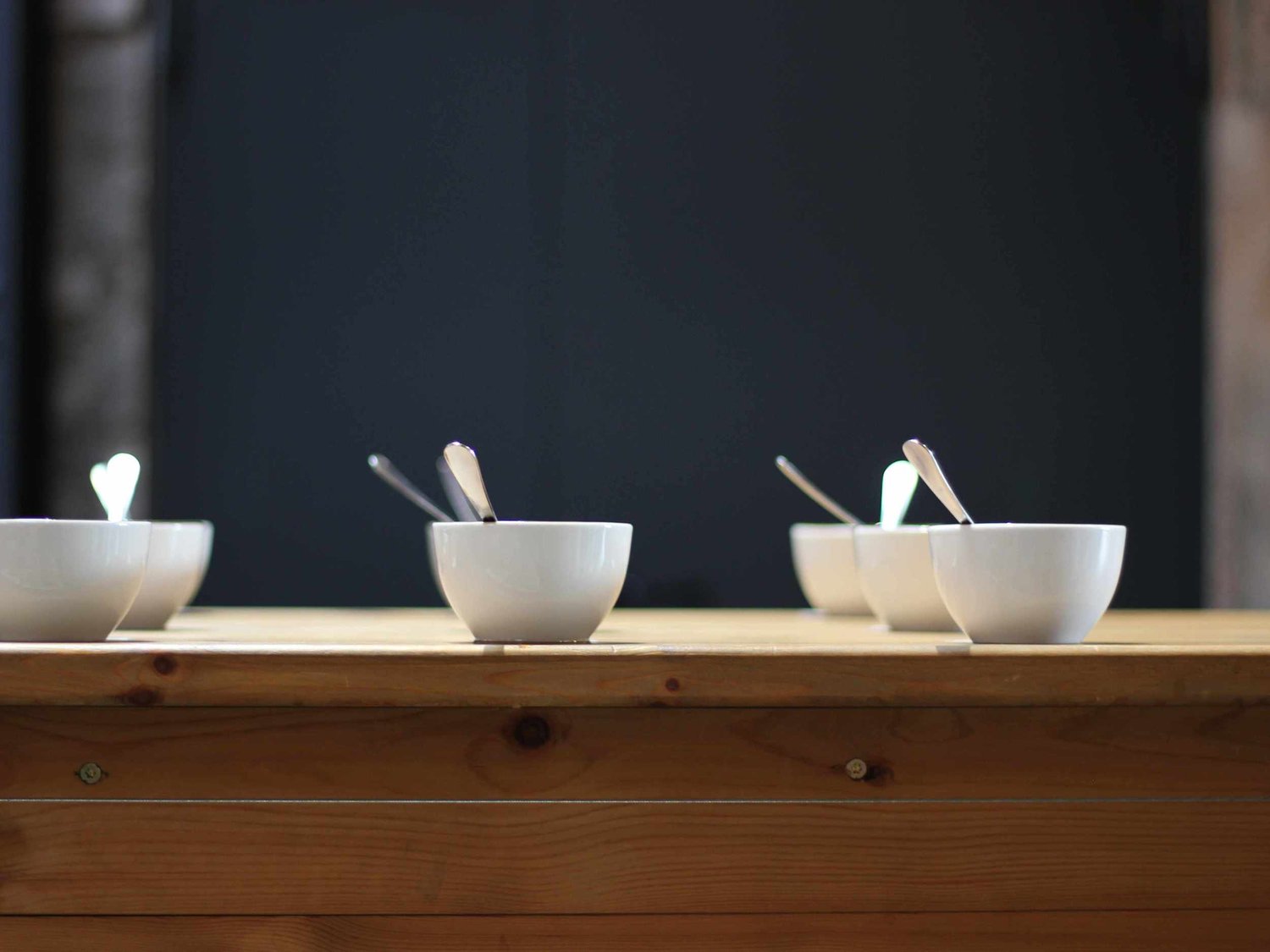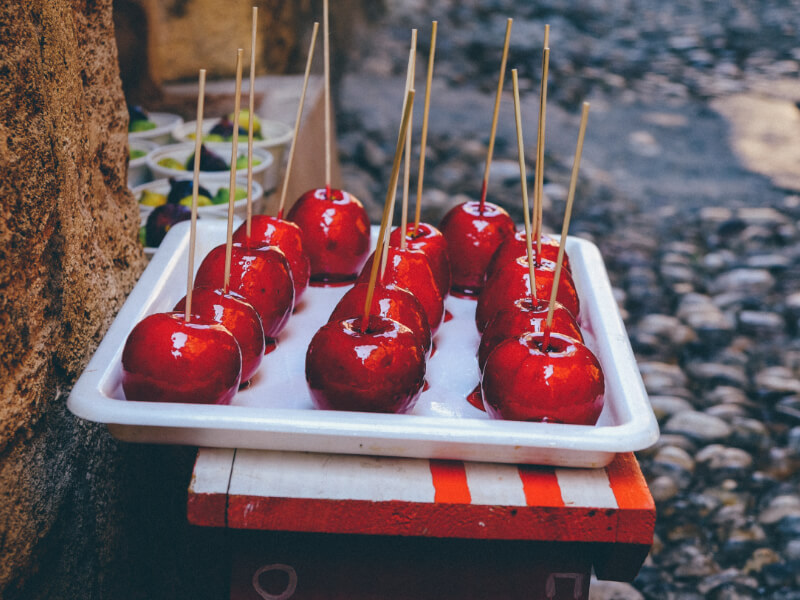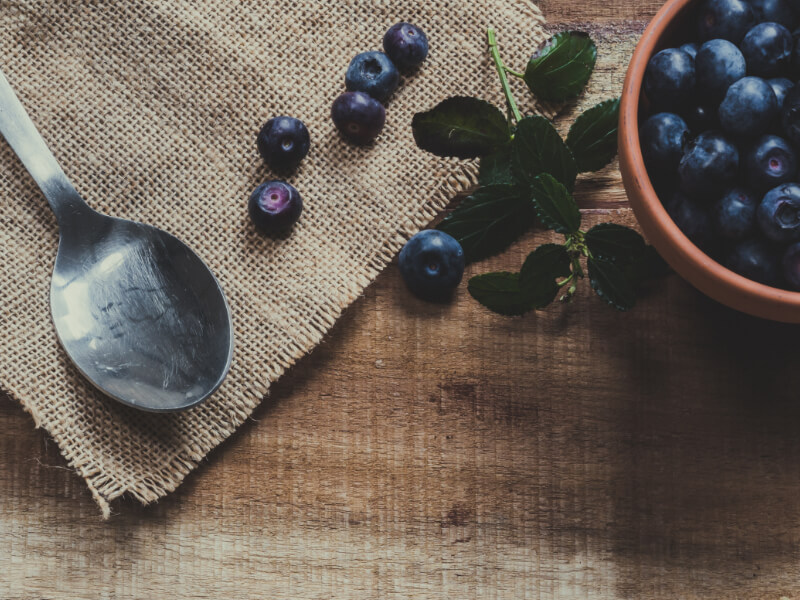
Some people are downright scary: among them are those who describe the taste of their coffee in the most beautiful and apt words.
"Notes of dark cherry, raisin and red grape with a tangy, complex acidity reminiscent of black currants and rhubarb, a syrupy body and a snappy, short aftertaste."
So, could you see this coffee doing well in your cup?
For those of us who struggle a bit more with our sensory skills, we've got 10 suggestions for you on how to get better results in just a short time.
After an initial overview, we'll dive deeper with practical details below.
In a nutshell and for quick readers, these tips will make your cupping life more rewarding and joyful:
- Train basic tastes
Sweet, salty, sour, bitter and umami: Train correctly with simple recipes.
- Drink lots and lots of coffee
Helps: drink coffees from many growing countries with different preparation methods
- Eat attentively
Taste carefully what you eat more often
- Acids in coffee
Exercise with apples and lemons
- Thinking out loud
Exchanging ideas with coffee professionals works wonders
- Practicing coffee vocabulary
Putting flavors into words. Fortunately, there are coffee vocabulary providers.
- Perform triangle tests
Two are equal, one coffee dances out of line. Known from cupping championships.
- Taste coffees from one country of origin.
Be able to identify and describe regional differences in the cup.
- Train aromas
Using essential oils to trace the aromas in coffee.
- Sensory perception and memory go hand in hand
If you understand how sensory stimuli reach the brain, you can train more effectively.
For those who want to dive deeper into each of these tips, keep on reading and - if you wish - start praticing right away. Enjoy the practice and the feeling of growing better at the next cupping.
#1: Training the basic taste
Sweet, sour, salty, bitter, umami - These are our basic tastes. If we want to describe the flavor profile of a coffee, we need to know what sweet or sour feels like on our tongue.
That's why regular training is best done only with sugar and salt solutions that you can make yourself.
Here you will find indications for each basic taste. The ideal is to mix them with hot water and taste them when cold. The recipe refer to 1 liter of water.
Accessories: clean bottles, scale, water (e.g. distilled water), base flavor.
Procedure: Weigh base flavor for one liter of water and pour into a clean bottle. Fill up with hot water until one liter is reached. Mix well and let cool.
Recipes
- Sweet: 24 grams of sugar to one liter of water
- Sour: 1.2 grams of citric acid to one liter of water
- Salty: 4 grams of sodium chloride to one liter of water
- Bitter: 0.54 grams of caffeine to one liter of water
- Umami: 2 grams of monosodium glutamate to one liter of water
Tip: If a liter is too much for you, convert the recipe to a size that works for you, such as 600 ml, 500 ml, or 400 ml.
#2: Drink lots and lots of coffee
What helps you train your sensory skills is drinking coffee. And drink more coffee. And again, drink coffee.
Pay close attention to your sensations in the roof of your mouth, on your tongue, and on your nose:
- What aromas do you perceive?
- How liquid or thick does the coffee feel in your mouth?
Try as often as possible to taste coffees
- from different growing countries,
- with different preparation,
- with different cultivars,
- different roasts and, if possible,
- from different harvests.
This applies to both Arabica and Canephora varieties. What you can do specifically: Try coffees from different fellow roasters. Or keep an eye out for cuppings from green coffee vendors or from other vendors (e.g., coffee schools).
If it works for you, take notes on the coffees.
The best time to train your basic palate is mornings between 10 and 12. The palate is still free from the influences of the day.
#3: Eat mindfully
Start consuming food mindfully: What does the texture of a tomato feel like? Is lemon really just sour, or can it be a little sweet?
Practice: Try describing the differences between lime, lemon and grapefruit.
Each food, just like coffee, brings with it characteristics such as sweetness, sourness, bitterness, aftertaste, and texture. With each food, practice consciously noticing these qualities and storing them in your memory.
Practice: Try to associate the properties of a lemon or a tomato with an appropriate image in your memory.
#4: Train with acids in coffee
By acids in coffee, we in particular mean these: lactic acid, tartaric acid, citric acid, and malic acid. Each of these acids provides different properties in the coffee sensory system. Lots of lactic acid in coffee, for example, results in a creamier mouthfeel and a milk-like body to the coffee. To train your sensitivity to these acids in coffee, you can do the following:
Brew yourself an aromatic but not too flashy coffee, such as a Brazil Santos. Take 50 grams of ground coffee for one liter of coffee. Distribute the brewed coffee into five cupping bowls. Each bowl now contains an equal amount of coffee. Add one of the above acids to four of the five cupping bowls, 0.2 grams each.
Your goal are five cupping bowls:
- One contains pure coffee,
- one contains pure coffee mixed with 0.2 grams of lactic acid,
- one contains pure coffee mixed with 0.2 grams of tartaric acid,
- one contains pure coffee mixed with 0.2 grams of citric acid, and
- one cup contains pure coffee blended with 0.2 grams of malic acid.
Taste all the coffees and compare them to the pure coffee.
Next, reverse the order of the coffees and blindly identify which cupping bowl has which coffee in it.
Did you know?
Smells are transmitted very slowly within the body: It takes 400 milliseconds for us to perceive an olfactory stimulus.
By comparison, we perceive an optical stimulus in 45 milliseconds.
Remembering odors also takes time. Between 600 and 800 milliseconds are needed to awaken a memory through an olfactory stimulus.
#5: Talking about coffee with other coffee professionals
While the actual cupping is a silent affair, you'll benefit immensely from sharing with your peers after cupping.
Together, discuss every single coffee on the table. And do so using a cupping evaluation sheet that you used during the cupping. You will note the characteristics of each coffee on this evaluation sheet during the cupping. What qualities does each coffee bring to the table, what does the aroma remind you of, what does the sweetness and aftertaste remind you of? How many points did everyone give this coffee?
Practice: Together, also try to think about the target audience or purpose (for example, roasting it as a filter coffee or as an espresso) for which it may be suitable.
#6: Practice coffee vocabulary
Sometimes it's hard to find the appropriate words to describe coffee. Consult existing material here, such as
- an aroma wheel or
- the Sensory Lexicon from World Coffee Research.
You can put the material in sight and consult it during the first tasting.
Then, in a second step, try tasting the same coffee again: this time, however, only with a white sheet of paper and try to write down your own thoughts for each coffee. Compare your two results.
2 proven ways to remember aromas well
Scents, and flavors are nothing else, we can remember better if we do the following:
1. we try to name the scent
2. we associate the scent with an event from our lives
Lyman and McDaniel proved in 1986 that these two methods work better instead of simply smelling or picturing a scent.
#7: Drink coffees from a single growing country
Each coffee-growing country offers different micro-climates and therefore different flavors. Try tasting many different coffees from a single country of origin. You'll learn how different the aromatics can be in one country. Cuptasting coffee championships in particular like to use coffees from a few countries.
#8: Conduct triangle tests
Triangle tests and in/out tests are a very good way to train your sensory skills.
Triangle tests are used, for example, at coffee championships in the sensory discipline. The task is to find the coffee from a set of three that differs from the other two.
The reverse is true for the in/out test: of the three coffees in the in/out test, one is the reference coffee. Of the other two coffees, the one that is identical to the reference coffee is to be found. This test often occurs in quality control tests to ensure the sameness of the product.
The beauty of these two sensory tests is that the difficulty is easy to adjust. You can find more about these two tests in a separate article about them.
#9: Train aromas
Get a variety of essential aromas that are found in coffee, such as lime, dark chocolate, or blueberry.
You can also use a set that suppliers have put together for you, for example
- Olfactorium from Belco in France,
- Aromabar from Hamburg,
- T100 from ScentOne or
- Le Nez du Café.
Practice assigning the different aromas correctly. Training aromas as little as once a month can produce impressive results.
#10: Learn how the brain works
If you know how the sensory perceptions of your tongue and nose arrive in the brain, you can better use this knowledge in learning about your sensory system.
Specifically, it improves for you:
- You understand how your body perceives coffee.
- You learn when you perceive salty and when your tongue reports bitter.
- You learn how your memory learns flavors and makes them available again.
- You'll learn how to better remember characteristics and how to use your senses to improve sensory perception.
The magic of improving your sensory system lies primarily in practice, practice, and more practice.





